
The Lighthouse in the Hayfield
Photograph by Leon Barron
Fieldwood Heritage Society
Canning, Kings County, Nova Scotia
Borden Lighthouse, (#161 on the 1912 List of Lights) was built in 1904 at Borden Wharf on the south side of the Habitant River, about 150 metres below (downstream) from the present, and the more-recently constructed, Aboiteau Road. Remnants of the pilings are still in place and mark its location.
It was known as the "Light in the Hayfield" because marsh grass was harvested
around it for use in winter as "salt-hay fodder". The light was used until the
early 1930s, with Fred Clark as the most recent lightkeeper. In 1955 Gordon
Bayne, Superintendent of Lights at that time (Gordon still lives in Wolfville,
and remembers), authorized Charles Borden and Stewart Brown to move the building
if they wanted it, otherwise it would be burned.
The light house was moved April 21, 1959. The railing and lantern were removed, the top cut off and burned, and the main building taken to Brown's farm to house pigs. Later, in 1980, it was given to Al Hazel who moved it to Pereau Road and used it to store tools. The Village of Canning rescued the lighthouse in 1990 for use as a Tourist Information Centre. The Village has now given it to the Fieldwood Heritage Society, which plans to restore the building and reconstruct the top.
In the 1800s and early 1900s the harbour at Canning included private and government wharves. The harbour was a busy one with, at harvest time, many vessels lined up waiting their turn to tie up at the wharf to load farm produce, mainly apples and potatoes, and deliver such cargoes as coal and
grindstones for the nationally known Blenkhorn Axe Factory.
Canning Master Mariners, including the Potter family (Capt. Henry, father, and four sons, Capt. Jacob, Capt. Henry, Capt. William, and Capt. Alfred) commanded such locally-built (Canning, Kingsport, Scotts Bay) ships as the Boniform, Blomidon, Providence, Kings County, Nova Scotia, Cornwallis, and Habitant.
These and other mariners carried on an active trade between Nova Scotia and the seaboard of the United States, as well as with the West Indies and England. When World War One started, Capt. Alfred Potter returned to sea from retirement to carry lumber from Halifax to England and, despite mines and submarines, completed one trip in 16 days.
The Canning harbour was also noted for ship-building with, beginning in 1840,
four ship-building industries located here. Dr. William Baxter MD possibly
built the first ship in Canning, a small schooner needed to ship farm produce,
especially to the Boston area. Later, a W.H. Baxter built the Schooners
Preference, A.B. Barteau and the W.H. Baxter.
The Bigelow family were noted ship-builders. The Sch. Blomidon, Conductor, General George C. Hogg, Fieldwood (name-sake of the Heritage Society) and others were built in the
Bigelow Shipyard in Canning.
In the 1800s Canning was the largest community in the eastern Annapolis
Valley. With a population of over 3000, it was larger than Kentville and
Wolfville, and was a centre of industry and commerce.
In the early 1900s the Cornwallis Supply Company of Canning operated a weekly freight and ferry service (the S.S. Brunswick) between Canning and Saint John, New Brunswick. This
made Canning a major port of entry into central Nova Scotia for New Brunswick businessmen, as well as a community frequently visited by senior federal politicians (including Prime Ministers Borden and Laurier) to visit Sir Frederick Borden. These visitors stayed at Canning's well-appointed hotels.
One hundred and more years ago, Canning was a prosperous community based primarily on agriculture, its harbour, and the ship-building industries. Then, beginning with construction of Borden Light in 1904, ships were guided into Canning Harbour by lights at Kingsport, Porter Point (Picket Wharf) and Borden Wharf. Pre-1944, the agricultural fields along the Habitant River were protected by an aboiteau and a system of dykes. This aboiteau was located upstream from the Canning wharf and the wharf remained active.
In September 1944 this aboiteau broke, flooding farm fields. A new aboiteau was completed in 1945, but was located downstream near Borden Wharf. This aboiteau closed the harbour and associated industries. The new aboiteau and highway, having a "causeway effect", increased sedimentation (to more than 2 metres), backed-up the water, and flooded more deeply the original site of Borden Light at high tide. The site is no longer readily accessible.

Photograph by Leon Barron
| Also see |
|---|
|
Photographs of the construction of the new top 2003-2004
Photographs of the installation of the new top 7 July 2004 Photographs of the relighting celebration 4 September 2004 |
(held by the Fieldwood Heritage Society)
The Society has a photograph of the Borden Light
on its original site (above). This is the only known photograph of this lighthouse in its original location.
We have plans for an identical lighthouse, a 27-foot pepperpot, the Digby Pier Lighthouse Tower. (The Coast Guard in Saint John does not have plans for the Canning Light.)
We have the following information, from the 1912 List of Lights:
(1) It was located on the south side of Canning (Habitant) River,
at latitude 45°08'45"N, longitude 64°24'01"W.
(2) There was a fixed (non-rotating) red light. The original light source
was an oil lamp but we hope to incorporate a solar-powered electric light.
(3) The building was wood, painted white, standing on piles and 27 feet 8.2 metres from base to vane. It was built in in 1904, and was visible in
the straight reaches of the channel to the northward and westward.
From the Lightstation Inspection Report, August 27, 1956, we note the following
with reference to the
Porter Point Light:
Type of apparatus D
Order of lens 6th
(description, 6th order Fresnel lens)
Can we assume the Borden Light was the same?
At the east end of Canning's business section, the Village has established
the "Shipyards Park" on land that once was, in part, Bigelow's shipyard, and photos and notes of shipbuilding are displayed. At the west end of the business section is the Canning Library and Heritage Centre, the latter operated by the Fieldwood Heritage Society.
South of the Heritage Centre, along the Habitant River, is the site of the former, busy wharf. The lighthouse will be placed beside the river behind the Heritage Centre. The society hopes that the lighthouse will provide the impetous to improve the walk along the site of the Government Wharf, the former Canning Harbour, to the Shipyard Park. It is intended to have interpretive signs on the site, showing the original location of the Light, the importance of the harbour, and both the Borden Wharf and Porter Point (Picket
Wharf) Lights.
The Light will be on property purchased by the Canning Library and Heritage Association (deed held by Village of Canning), south of the Canning Library and Heritage Centre, on the site of the former Government Wharf, on the bank of the Habitant River. As the lighthouse was moved from its original site, April 21, 1959 (above), and that site has been made unsuitable by the replacement aboiteau built in 1945, it was decided to place it at the former Government wharf, a site that we believe is an appropriate one. This site is in the heart of the Village, there is access by road, and room for parking. The area will be lightly landscaped to retain a natural look. There is a view of the dykelands across the river to the south, on the north is the Library and Heritage Centre, and to the west is the Royal Canadian Legion building. To the east is the walkway to the Shipyards Park, which we hope will be made an attractive walk between the Park, Lighthouse, and Museum. We believe that the grouping, Museum, Lighthouse, and Shipyards Park, will be an attractive historic centre for our Village.
Funding for Lighthouse maintenance will be provided by the Fieldwood Heritage
Society. The Society wishes to thank the J.M. Kaplan Fund of New York, which through the Nova Scotia Society for the Preservation of Lighthouses has funded this restoration project with a grant to be matched by the Society.
On Sunday, June 22, 2003 the lighthouse was moved to its new home on the
banks of the Habitant River by Eric Meek, John Newcombe and Terry Porter.
Restoration will commence soon.

Photographed 5 May 2004

Photographed 29 May 2004
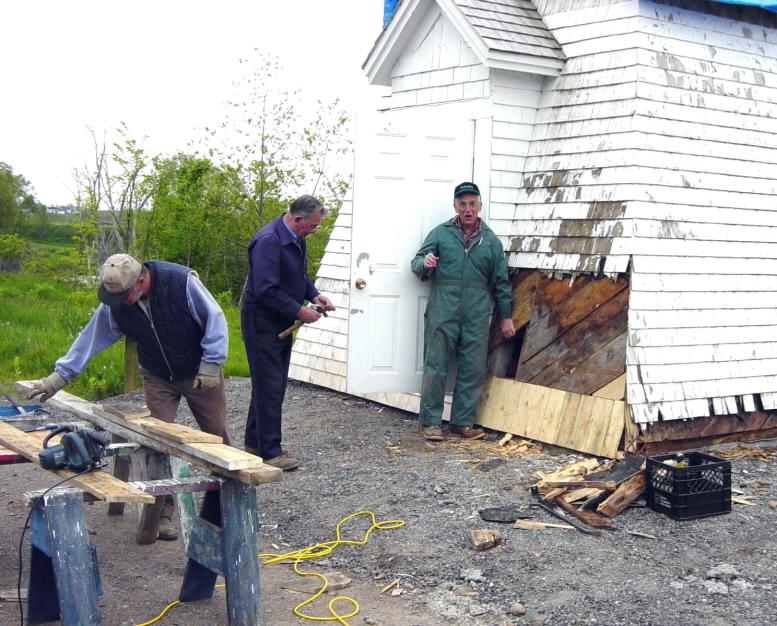
Photographed 7 June 2004
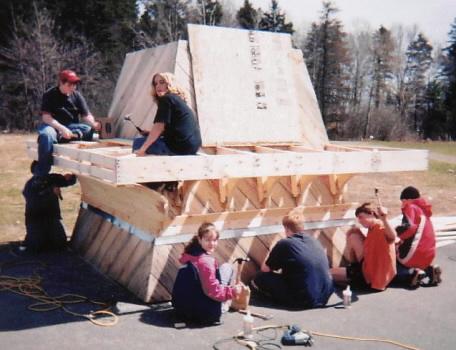
Photograph by Kevin Wood
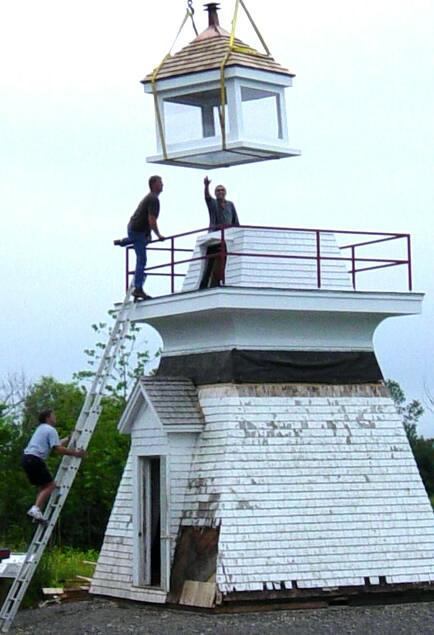
Photographed 7 July 2004
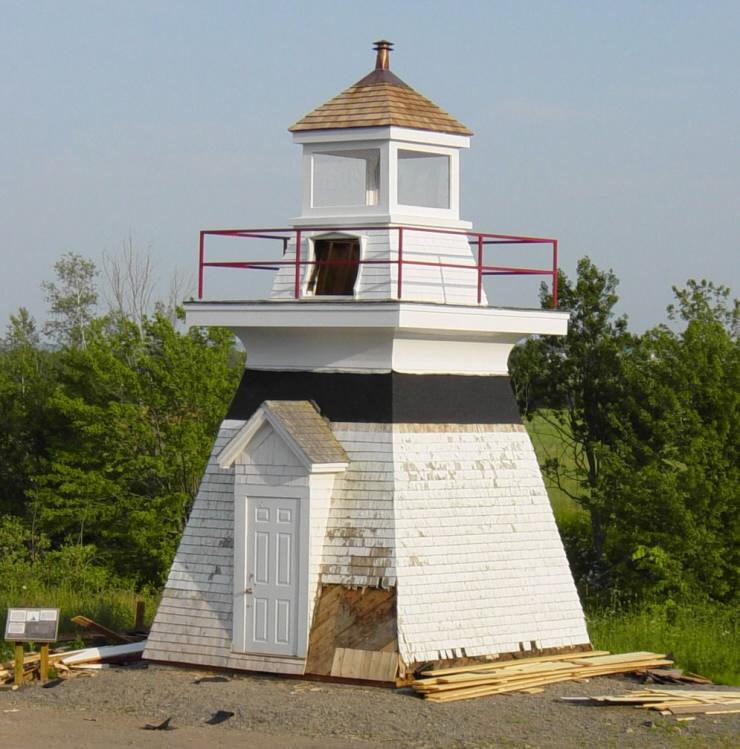
Photographed 13 July 2004
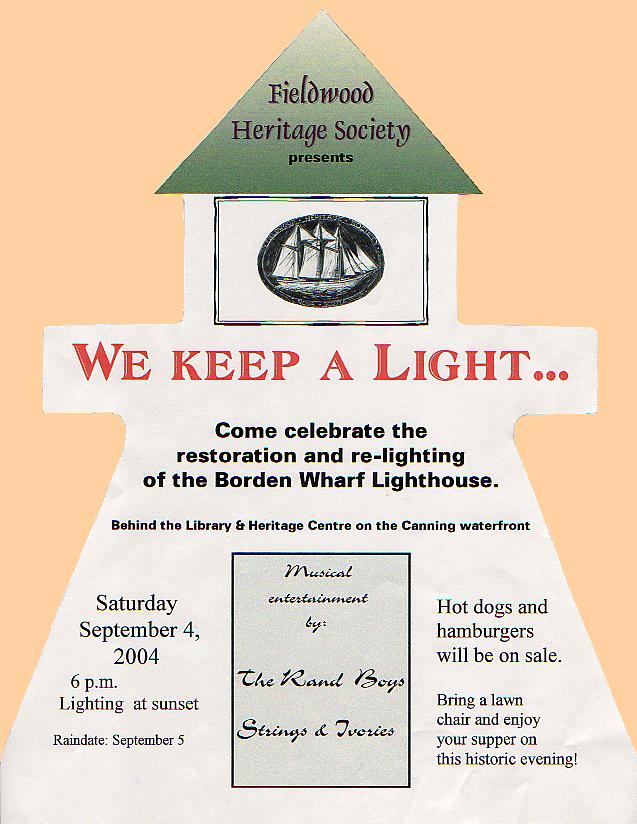
Poster by Neil Bennett

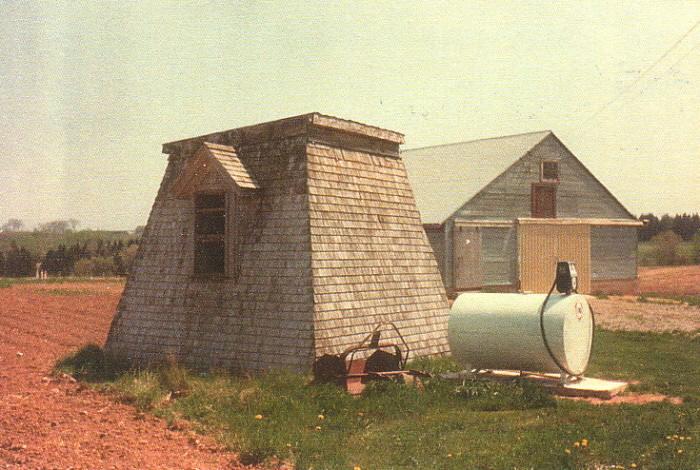

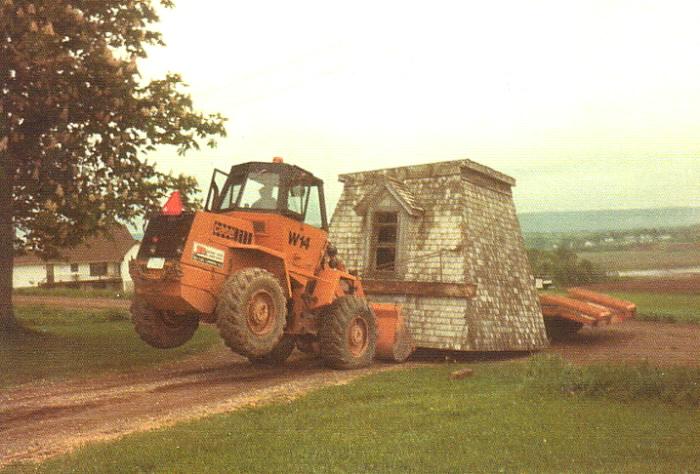
The Society has received a copy of the eight principles for heritage repairs and construction, and will adhere to them.
Brought to you by the
Nova Scotia Lighthouse Preservation Society (NSLPS)
NSLPS, in consultation with other heritage building
organizations and other lighthouse societies, has adapted the following heritage
buildings principles for development and preservation work at lighthouse sites.
These principles are derived from internationally recognized heritage building
principles, originally based on the
Venice Charter for the Conservation and Restoration of Monuments and Sites, 1964.
Note: These basic principles can be applied to the restoration/preservation of any historical structure.
(The first attempt to establish a coherent and logically defensible philosophy for building conservation was in the
Society for the Protection of Ancient Buildings' Manifesto of 1877.)
Minimal intervention shall be the guiding principle. To maintain the historical content of the resource. Wherever possible conserve, repair and reuse building materials and finishes. Where necessary, repair with like materials.
Lighthouse sites have evolved over time. Do not arbitrarily remove a building or feature of a building solely to restore to a single period of time or commercial theme.
If alterations are unavoidable, they should be made in a way that allows the building to return to its original state. This conserves earlier building design and technique. Any changes should be fully documented.
Additions to a historic building should be distinguishable from the original. While the addition should harmonize and not overwhelm the original, they should not blur the distinction between old and new.
Buildings should only be moved if there is no other means to save them. Site is an integral component of a building. Change in site diminishes heritage value.
The value of a site is not just the building but the setting which reflects its history. This applies not to just great works of architecture but also modest and humble sites which have acquired importance through time and community association. The scale and style of any new building should complement the site.
Disturbance of soil during construction must be monitored to ensure significant historical or archaeological information is not destroyed.
Conservation and restoration work shall be based on historic documentation such as historic photographs, plans and physical evidence, never on conjecture.
Link to Relevant Website
Discussion of Bill S-7: Preservation of Historic Lighthouses
|

|
W3C HTML Validation Service http://validator.w3.org/ |
W3C CSS Validation Service http://jigsaw.w3.org/css-validator/ |
|
This FHS website is generously hosted by Ednet.
Nova Scotia Department of Education |